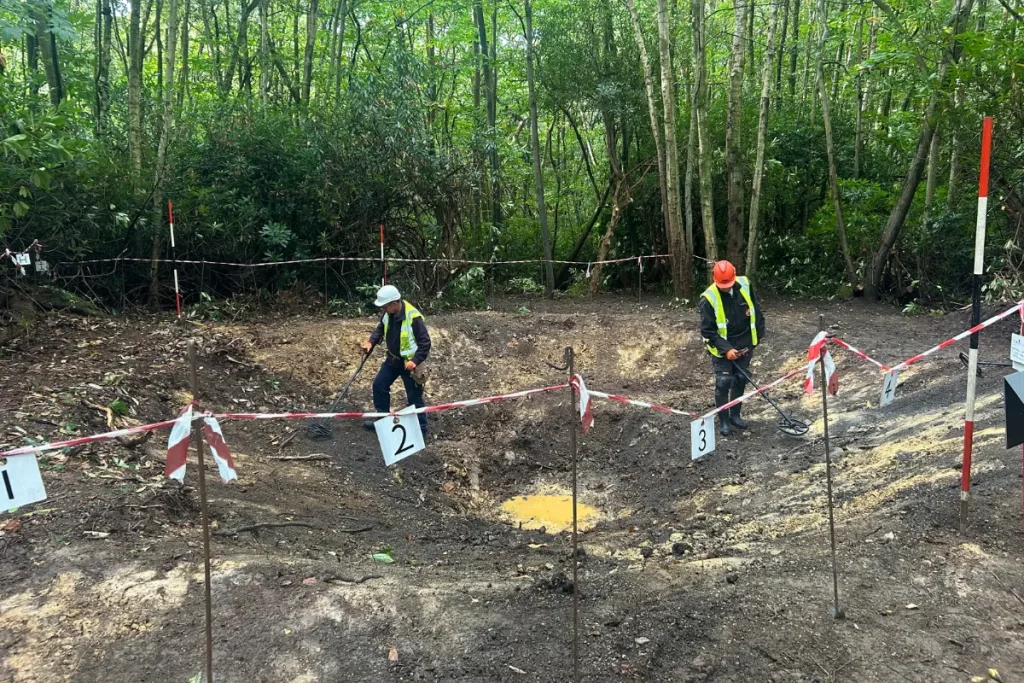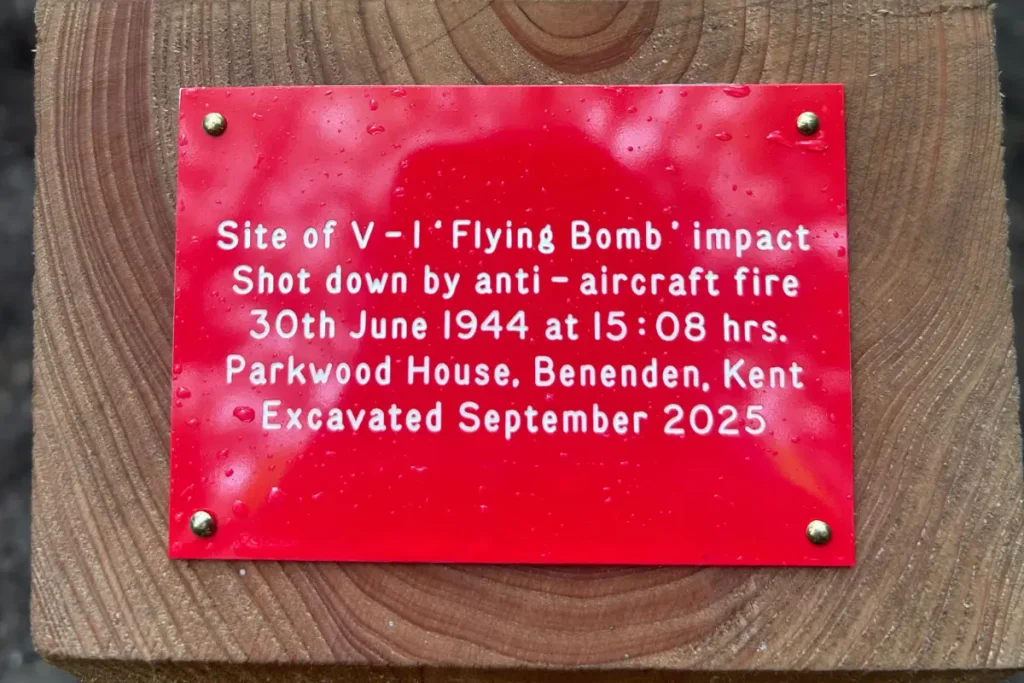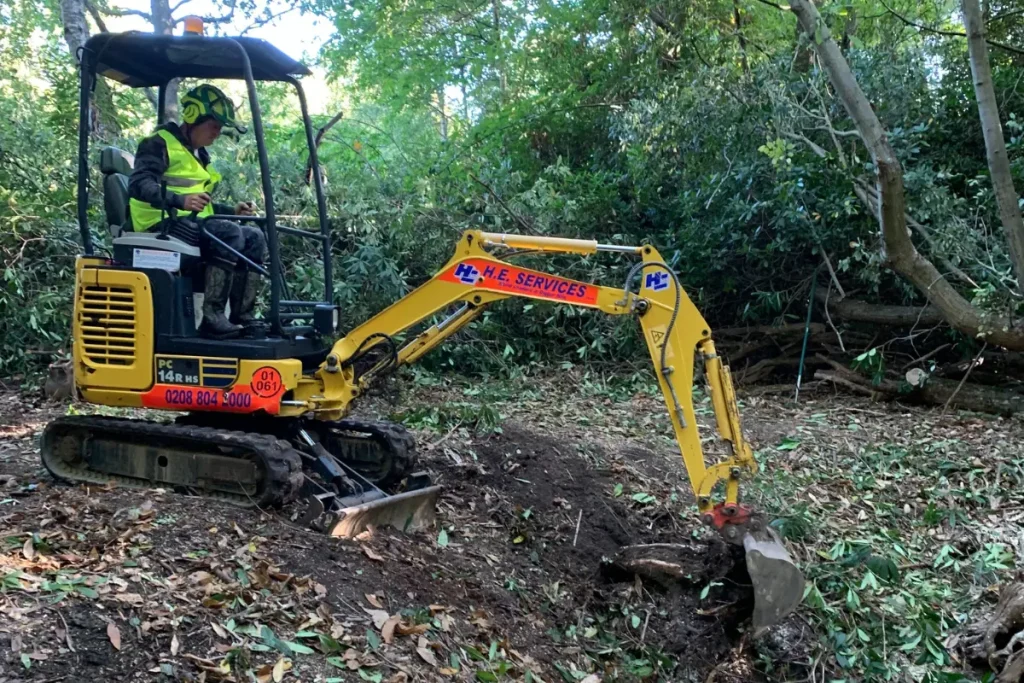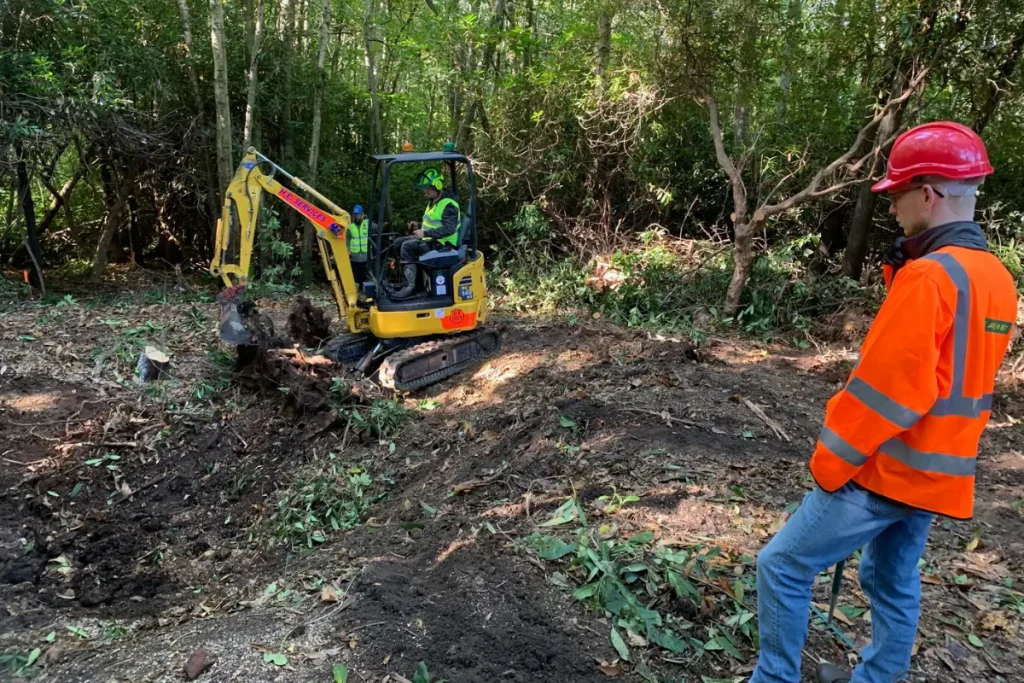H. E. Services is collaborating on a remarkable project that is taking place in the Kent countryside. A V1 rocket excavation site in Benenden, Kent. Beneath the rhododendron thickets and quiet woodland lies a scar of the Second World War: the impact centre of a German V1 flying bomb, which fell on 30th June 1944. For decades, it has remained untouched, shielded by nature and memory. Now, a dedicated archaeological team, with the support of landowners, local authorities, and Benenden School, is carefully unearthing the site to shed light on the history of Britain’s fight against Hitler’s so-called “vengeance weapons.”
This excavation offers not just the opportunity to recover physical fragments of the flying bomb, but also to answer vital historical questions about how it was brought down, the scale of its destructive power, and the effectiveness of Britain’s anti-aircraft defences during the summer of 1944.
The V1 Flying Bomb: A Brief History
The V1, known colloquially as the “doodlebug” or “buzz bomb” due to the distinct pulsing sound of its engine, was Nazi Germany’s first operational cruise missile. Launched from northern France from June 1944 onwards, it was designed to terrorise Britain into submission.
Powered by a simple pulsejet engine and carrying a warhead of nearly one tonne of high explosive, the V1 had a range of roughly 150 miles. Its guidance system was primitive: essentially a gyroscopic autopilot and a timer that cut the engine, sending the missile into a terminal dive.
Between 1944 and 1945, over 9,500 V1s were fired at Britain, with London as the principal target. More than 2,000 struck the capital, causing widespread damage and civilian casualties. Defences against the V1 included barrage balloons, fighter aircraft, and anti-aircraft guns, all coordinated in a frantic attempt to prevent the bombs from reaching their intended targets.
The Benenden V1 was recorded in the Kent County War Diary as having been shot down by anti-aircraft fire, falling harmlessly in woodland. Thankfully no lives were lost, though eight surrounding houses were damaged. Today, the excavation offers a rare opportunity to verify these earlier records against physical evidence.
The Benenden Site
The impact crater lies in rhododendron woodland in the Kent countryside. Although partially infilled and overgrown, the crater remained visible as a 9-metre depression with a subtle raised lip.
Archival research has revealed much interesting information about the incident. On the afternoon of 30th June 1944, during a period when over 130 V1s were launched against Britain, the bomb destined for London was intercepted. Records suggest it was brought down by the 129th Light Anti-Aircraft Regiment, Royal Artillery, firing from a site close to its trajectory.
Post-war aerial photographs from 1946 clearly show the crater, surrounded by blast damage. Modern lidar surveys confirm the same feature, now softened by decades of soil erosion and vegetation growth. The survival of this site in such an undisturbed state makes it particularly valuable for study. It is also a site that is perfect for the Komatsu PC14 to operate.
Why Excavating Matters
At first glance, one might wonder why an old crater deserves such attention. The answer lies in both archaeology and memory.
Since 2010, Research Resource Archaeology, led by Colin and Sean Welch, has been conducting systematic studies of V1 and V2 impacts across southern England. Their work combines archival research, geophysical survey, and excavation to build a fuller picture of the V-weapons campaign.
One of their aims is to distinguish between bombs, both V1 and V2, brought down by fighter aircraft and those destroyed by anti-aircraft fire. At previous sites, evidence such as ammunition strikes on fragments has revealed the story of an individual weapon’s final moments. The Benenden V1 provides a unique chance to confirm anti-aircraft involvement, and potentially identify which unit was responsible.
This sort of forensic archaeology transforms vague historical claims into hard evidence, helping us better understand how Britain defended itself during one of its darkest hours.
The Excavation Plan
The V1 rocket excavation at Benenden is carefully structured. The project design lays out the key steps of the operation:
- Vegetation clearance: The dense rhododendrons must be cut back to allow safe access and visibility. A working exclusion zone of 20 by 20 metres will be marked out.
- Survey and recording: Magnetometer sweeps, detector surveys, and drone imaging will map the site. A grid system will ensure precise recording of finds.
- Crater profiling: Before excavation, the crater will be measured in four directions. Later, slot trenches will be cut to reveal the original profile.
- Excavation: An H. E. Services mini digger will carefully remove post-war infill, after which hand excavation will begin. Finds are logged, bagged, and photographed.
- Student involvement: Benenden School students take part under supervision, turning the excavation into a living history lesson. Something truly special for the next generation of historians.
The work is planned to last just under a week, with most significant discoveries hopefully being made over the second and third day.
Safety First
Archaeology of wartime sites is never without risk. Although the V1’s warhead detonated on impact, careful procedures are in place. A risk assessment and health and safety policy govern the excavation, ensuring both professionals and volunteers work safely.
The site features a controlled entry point and protective equipment for workers.. Experienced machine operators, with training in this type of archeological dig, are on hand to operate the excavation machinery itself.
Such precautions are essential, but they also reflect the professionalism with which this excavation is being carried out.
What Might Be Found During the Course of the Dig
The initial survey in December 2024 uncovered only a small number of shallow targets, mostly aluminium fragments and ferrous pieces. This is unusual compared to other V1 sites, which often yield more recognisable wreckage.
Possibilities include:
- Aircraft damage evidence: If the V1 was struck by anti-aircraft fire, surviving fragments may show perforations consistent with 40mm ammunition.
- Structural components: Sections of wing elevators, fuselage skin, or engine parts.
- Contextual material: Blast debris, post-impact infill such as clinker and brick, or even remnants of firefighting efforts.
Early finds included a large part of the V1 shaft, as well as part of the bomb which affixed the wings to the shaft. Interestingly, these parts were found aboveground. More interestingly, their positioning begs even more questions of the site. By the time the dig is complete, it would not be surprising if many more historically significant pieces are uncovered.
Whatever is discovered in Benenden will be added to the broader Research Resource Archaeology collection, which is never sold but carefully conserved for study and eventual display in a major museum.
Community and Education
One of the most exciting aspects of the Benenden excavation is its educational value. Local students will not only witness history being uncovered but also participate in the careful process of recovery and recording.
For Benenden School, located just beyond the site boundary, this is an extraordinary opportunity. Students will see how archaeology, history, and science intersect. They will handle the physical consequences of war and gain a deeper understanding of the sacrifices made to protect Britain in 1944.
Moreover, the excavation fosters community involvement. Landowners, Kent County Council, and local residents all play a role in preserving and interpreting their shared heritage.
From Benenden to the Bigger Picture
The story of the Benenden V1 is not just local. It ties into the wider history of Britain’s battle against the V-weapons campaign. Each excavation adds to a growing body of knowledge: how many bombs were brought down, by what methods, and at what cost.
Previous projects, such as the excavations at King’s Wood and Bayland Wood, revealed significant insights into aerial interception. Now Benenden may provide the clearest evidence yet of effective anti-aircraft defence in Kent during late June 1944.
Such work also ensures that the memory of those who fought, including the men of the 129 Light Anti-Aircraft Regiment, who “drew first blood” in the war against pilotless aircraft, is not forgotten.
Looking Ahead
Once the excavation concludes, an interim report will be published, with a final report to follow after conservation and cataloguing. These findings will contribute to the Kent Historic Environment Record and the national understanding of the V-weapons offensive.
In time, the fragments recovered at Benenden may sit in a museum case alongside others from across the country, telling the story of resilience, defence, and survival.
Conclusion
The V1 rocket excavation at Benenden is far more than a dig in a Kentish woodland. It is an act of remembrance, a pursuit of truth, and a bridge between past and present. By uncovering the wreckage of a flying bomb intended to terrorise London, archaeologists and local partners remind us of the courage and ingenuity that defended Britain in 1944.
As spades, trowels, and the H. E. Services Komatsu PC14 lift fragments from the soil, they also lift stories long buried, stories that connect the quiet fields of Benenden to the global struggle of the Second World War.
Give us a call on: 0208 804 2000 or email us for a quote.
For more special offers and construction news, don’t forget to follow us on social media:
Facebook – https://www.facebook.com/planthireHE/?locale=en_GB
LinkedIn – https://www.linkedin.com/company/h-e–services-plant-hire-ltd/
Instagram – https://www.instagram.com/planthirehe/
Information correct as of: September 2025









